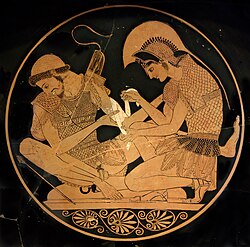Trojan Battle Order
The Trojan Battle Order or Trojan Catalogue is an epic catalogue in the second book of the Iliad listing the allied contingents that fought for Troy in the Trojan War. The catalogue is noted for its deficit of detail compared to the immediately preceding Catalogue of Ships, which lists the Greek contingents, and for the fact that only a few of the many Trojans mentioned in the Iliad appear there.
Structurally the Trojan Battle Order is evidently inserted to balance the preceding Catalogue of Ships. It is, however, much shorter. Denys Page summarizes the prevailing explanation that "the Catalogues are substantially Mycenaean compositions rather expanded than altered by the Ionians" (Page 1963, pp. 153–154). Noting that the Greek catalogue occupies 265 lines but the Trojan catalogue only 61, Page wonders why the Ionian authors know so little about their native land and concludes they are not describing it but are reforming poetry inherited in oral form from Mycenaean times (Page 1963, pp. 137–139).
Some examples of Mycenaean knowledge are (Page 1963, pp. 141–143):
There is also some internal evidence that the Trojan catalogue was not part of the Iliad but was a distinct composition pre-dating the Trojan War and incorporated later into the Iliad (Page 1963, p. 140):
Page cites several more subtle instances of the disconnectedness of the Trojan catalog from the Iliad; neither is it connected to the catalog of Greek forces. Another like it appears in the Cypria (Burgess 2004, p. 138).
The catalogue lists sixteen contingents from twelve different ethnonyms under 26 leaders (Luce 1975). They lived in 33 places identified by toponyms.

Achilles tending the wounded Patroclus
(Attic red-figure kylix, c. 500 BC)
...
Wikipedia
